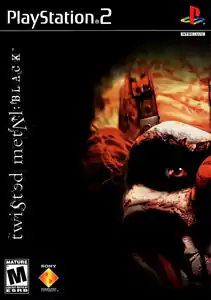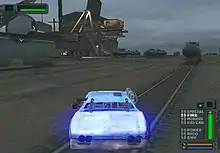| Twisted Metal: Black | |
|---|---|
 North American box art | |
| Developer(s) | Incognito Entertainment[lower-alpha 1] |
| Publisher(s) | Sony Computer Entertainment |
| Director(s) | David Jaffe |
| Producer(s) | Scott Campbell |
| Designer(s) | David Jaffe |
| Programmer(s) | Steve Poulson |
| Composer(s) | Michael Reagan Gregory Hainer Kevin Riepl Kevin Manthei |
| Series | Twisted Metal |
| Engine | Kinetica |
| Platform(s) | PlayStation 2 |
| Release | |
| Genre(s) | Vehicular combat |
| Mode(s) | Single-player, multiplayer |
Twisted Metal: Black is a vehicular combat video game developed by Incognito Entertainment and published by Sony Computer Entertainment for the PlayStation 2 video game console.[2] It is the first game developed by Incognito Entertainment. Santa Monica Studio assisted on development. It is a reboot of the Twisted Metal series and was released on June 19, 2001. An online enabled multiplayer-only variant, Twisted Metal: Black Online, was released later as a free send-away.
Both Twisted Metal: Black and Twisted Metal: Black Online were reissued as part of Sony Greatest Hits program. A standard downloadable version of Twisted Metal: Black is included in the first batch of copies of Twisted Metal for PlayStation 3, discernible by the "Limited Edition" tab near the top of the cover art. In December 2015, the game was made available for the PlayStation 4 through the PlayStation Network.
Overview
In concept, Twisted Metal: Black is a demolition derby that permits the usage of ballistic projectiles. Players choose a vehicle and an arena—or a series of arenas in the story mode—to engage in battle with opposing drivers. A variety of weapons and upgrades are obtainable by pick-ups scattered throughout the stage. The objective of the game is to be the last one standing.
The basis of the plot follows the same structure as in all the previous games: Calypso runs a car-based contest called Twisted Metal (though in the game the contest is never called that), in which the various characters compete risking their lives to claim the tournament's prize - any single wish they desire, no matter the difficulty, rarity or even reality of such wish. Although Calypso is indeed malevolent, characters who have malevolent wishes (which make most of the cast) have their wishes granted without him tricking them on the wishes, while those seeking more noble ends (such as Outlaw's driver Agent Stone) find that Calypso usually has the last laugh.
In a somewhat different take from previous games, each character has their own story, which they narrate from their own point of view. Each of them starts with them being visited by Calypso, who knows what they desire and offers them in his contest. More of the characters' background is revealed in their midpoint cutscene, presented as a dream experienced when they briefly pass out after the sub-boss Minion is defeated. The characters' ending movie showing their wish being granted is presented after defeating the final boss Warhawk.
The game instead takes place within a single city known as "Midtown", with most competitors coming from the city's mental asylum, "Blackfield".
Twisted Metal: Black has a diverse cast made up from both new and returning characters, some of which have changed drastically from their previous appearances. There are a total of fifteen selectable characters, in which ten of them are selectable from the very beginning and the other five must be found and unlocked.
Reception
| Aggregator | Score |
|---|---|
| Metacritic | 91/100[3] |
| Publication | Score |
|---|---|
| AllGame | |
| Edge | 6/10[5] |
| Electronic Gaming Monthly | 8.5/10[6] |
| Eurogamer | 9/10[7] |
| Game Informer | 9.5/10[8] |
| GamePro | |
| GameRevolution | A−[10] |
| GameSpot | 9.5/10[11] |
| GameSpy | 94%[12] |
| GameZone | 9.5/10[13] |
| IGN | 9.6/10[14] |
| Next Generation | |
| Official U.S. PlayStation Magazine | |
| The Cincinnati Enquirer | |
| Playboy | 90%[18] |
By July 2006, Twisted Metal: Black had sold 950,000 copies and earned $31 million in the United States. Next Generation ranked it as the 61st highest-selling game launched for the PlayStation 2, Xbox or GameCube between January 2000 and July 2006 in the States.[19]
Twisted Metal: Black garnered critical acclaim. It received a rating of 9.5 out of 10 from GameSpot[11] and a rating of 9.6 out of 10 from IGN.[14] In GameSpot's Best and Worst of 2001, the game was nominated for Best Shooting Game,[20] and came in ninth in their Game of the Year category.[21] It was also nominated in the "Best Graphics, Artistic" category.[22]
Many critics praised its dark and outstanding storylines for each character and its variety of weapons and unlockables, but its hover style controls for not changing much from the previous installments and its unbalanced difficulty were noted criticisms. Maxim gave the game all five stars and called it "a road rager's dream come true".[23] Playboy gave it 90% and called it "fun for the whole family!"[18] The Cincinnati Enquirer gave it four stars out of five and called it "a fight to the finish, so it's important to keep moving and to quickly learn how and when to use each of the weapons".[17]
Daniel Erickson reviewed the PlayStation 2 version of the game for Next Generation, rating it five stars out of five, and stated that "the best car combat game in history is also the most creative. Go get it".[15]
Twisted Metal: Black Online was a runner-up GameSpot's 2002 "Best Online Game on PlayStation 2" award.[24] During the 6th Annual Interactive Achievement Awards, Black Online received a nomination for "Outstanding Achievement in Online Gameplay" by the Academy of Interactive Arts & Sciences.[25]
Twisted Metal: Harbor City

A sequel project is Twisted Metal: Harbor City,[26] though it was never officially announced and the project was later scrapped.
Details on the game were revealed in the PlayStation 2 port of Twisted Metal: Head-On, Extra Twisted Edition. It was originally planned the levels of Harbor City to be greatly expanded and inter-connected with one another, giving a greater feeling of a single, complete world rather than stand-alone levels.
The four completed levels were included in the game as a bonus feature entitled Twisted Metal: Lost.
Webisodes
Animation S4, a producer of 3D and Flash animations, created a series of six original Flash "Webisodes" to promote the release of Twisted Metal: Black, beginning with No-Face, and including Billy Ray Stillwell, Dollface, Bloody Mary and Mr. Grimm.[27]
Notes
- ↑ Santa Monica Studio assisted on development.
References
- ↑ I. G. N. Staff (June 19, 2001). "Twisted Metal: Black Ships to Stores (Go Get It)". IGN. Archived from the original on April 9, 2023. Retrieved April 9, 2023.
- ↑ "Twisted Metal: Black Ships for the PS2". GameZone. May 4, 2012. Archived from the original on March 4, 2016. Retrieved June 19, 2012.
- ↑ "Twisted Metal: Black for PlayStation 2 Reviews". Metacritic. Archived from the original on October 24, 2013. Retrieved March 15, 2014.
- ↑ J.C. Barnes. "Twisted Metal: Black - Review". Allgame. Archived from the original on November 14, 2014. Retrieved March 16, 2014.
- ↑ Anon. Edge staff (September 2001). "Twisted Metal: Black". Edge. No. 101. Bath: Future plc. p. 82.
- ↑ EGM Staff (August 2001). "Twisted Metal: Black". Electronic Gaming Monthly. No. 146. p. 110.
- ↑ Tom Bramwell (February 26, 2002). "Twisted Metal: Black Review". Eurogamer. Archived from the original on July 15, 2014. Retrieved March 16, 2014.
- ↑ Andy McNamara (July 2001). "Twisted Metal: Black". Game Informer. No. 99. Archived from the original on January 21, 2008. Retrieved March 15, 2014.
- ↑ Dan Elektro (June 19, 2001). "Twisted Metal: Black Review for PS2 on GamePro.com". GamePro. Archived from the original on February 12, 2005. Retrieved March 16, 2014.
- ↑ Shawn Sanders (June 2001). "Twisted Metal: Black Review". Game Revolution. Archived from the original on August 29, 2012. Retrieved March 15, 2014.
- 1 2 Ryan MacDonald (June 18, 2001). "Twisted Metal: Black Review". GameSpot. Archived from the original on November 3, 2014. Retrieved March 15, 2014.
- ↑ Russell Garbutt (June 29, 2001). "Twisted Metal: Black". PlanetPS2. Archived from the original on August 4, 2001. Retrieved March 15, 2014.
- ↑ The Badger (July 6, 2001). "Twisted Metal: Black Review - PlayStation 2". GameZone. Archived from the original on October 5, 2008. Retrieved March 16, 2014.
- 1 2 Doug Perry (June 18, 2001). "Twisted Metal: Black". IGN. Archived from the original on April 15, 2014. Retrieved March 15, 2014.
- 1 2 Erickson, Daniel (August 2001). "Finals". Next Generation. Vol. 4, no. 8. Imagine Media. pp. 80–81.
- ↑ "Twisted Metal: Black". Official U.S. PlayStation Magazine. 2001.
- 1 2 Marc Saltzman (June 11, 2001). "Road rage rules in racing games". The Cincinnati Enquirer. Archived from the original on May 21, 2008. Retrieved March 16, 2014.
- 1 2 Marc Saltzman (August 14, 2001). "Twisted Metal: Black". Playboy. Archived from the original on March 6, 2002. Retrieved March 16, 2014.
- ↑ Campbell, Colin; Keiser, Joe (July 29, 2006). "The Top 100 Games of the 21st Century". Next Generation. Archived from the original on October 28, 2007.
{{cite web}}: CS1 maint: multiple names: authors list (link) - ↑ "Gamespot: The Best and Worst of 2001". Archived from the original on October 23, 2012. Retrieved June 4, 2007.
- ↑ "GameSpot: Top Ten Video Games of 2001". Archived from the original on December 27, 2001. Retrieved June 4, 2007.
- ↑ GameSpot VG Staff (February 23, 2002). "GameSpot's Best and Worst Video Games of 2001". GameSpot. Archived from the original on August 3, 2002.
- ↑ Boyce, Ryan (June 6, 2006). "Twisted Metal: Black". Maxim. Archived from the original on August 7, 2001. Retrieved November 16, 2014.
- ↑ GameSpot Staff (December 30, 2002). "GameSpot's Best and Worst of 2002". GameSpot. Archived from the original on February 7, 2003.
- ↑ "D.I.C.E. Awards By Video Game Details Twisted Metal: Black Online". interactive.org. Academy of Interactive Arts & Sciences. Retrieved August 2, 2023.
- ↑ "Twisted Metal Black Part II". IGN. Archived from the original on November 1, 2007. Retrieved November 20, 2007.
- ↑ "TWISTED METAL: BLACK WEBISODES". s4studios. Archived from the original on March 2, 2020. Retrieved March 2, 2020.